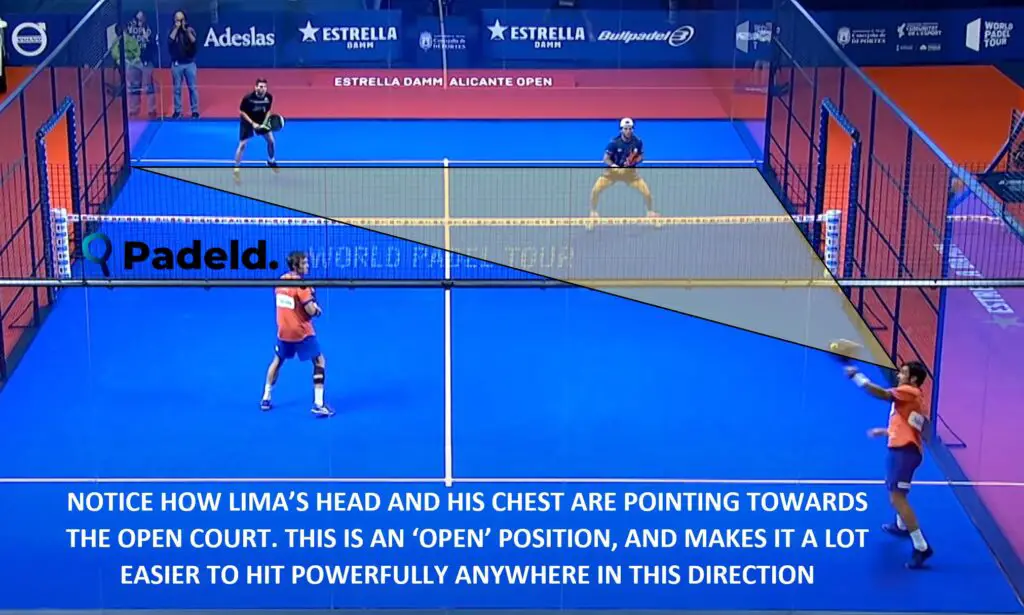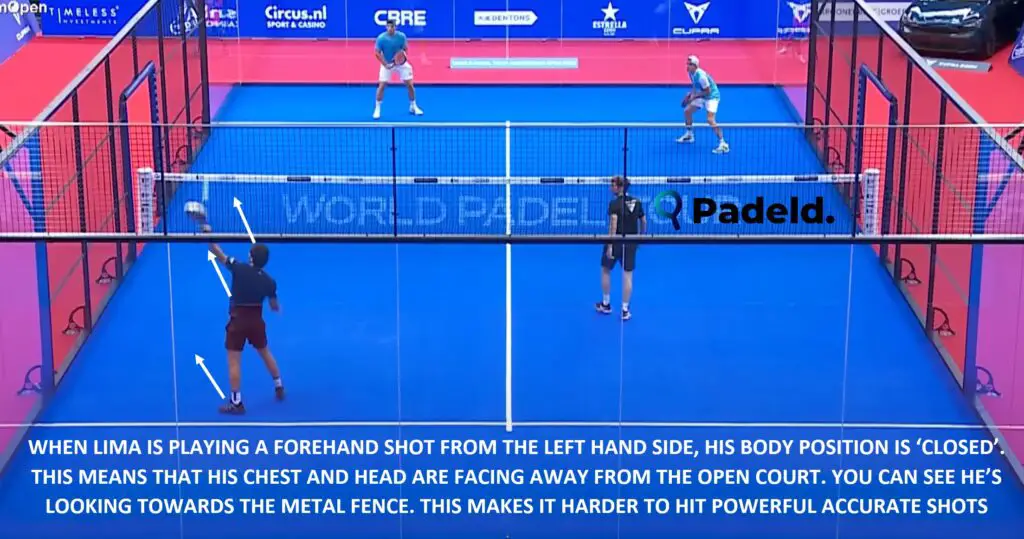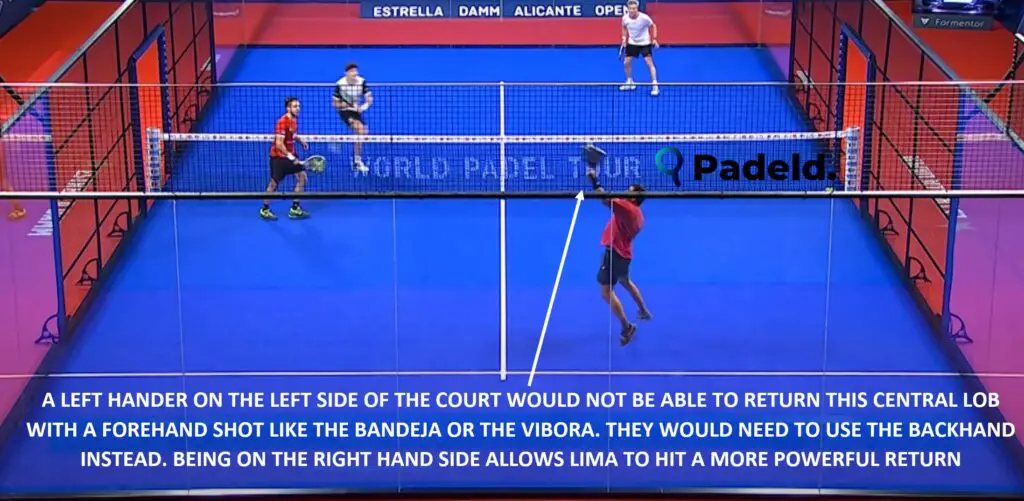Positioning in padel is one of the most important aspects of the sport. Getting yourself in the right positions means you can cover the court more effectively, which will make it harder for your opponents to score points and will also lead to you having more opportunities to put your opponents under pressure.
If you play padel at a good standard, I’m sure you’ll have come up against a pair of opponents where it seems as if it’s impossible for you to get the ball past them. I know I have! Most of this comes down to good positioning and being in sync as a duo. The more you play, the more you’ll get accustomed to the way you need to move around in order to be effective, and the more you play with a consistent partner, the easier it will be for you both form a solid partnership.
When padel duos feature both a left and a right handed player, I know there is often a lot of thought put into where both players should play. I’m a right handed player myself, but one of my favourite partners to play with is a left hander, and it took us a while to figure out which side of the court it would be best for each of us to play on. If you’re a left handed player and you’re also wondering whereabouts on the court you should play, that’s what I’ll be answering for you in this post!
So where should left handed players play in padel?
Left handed players should ideally play on the right hand side of the court. This position makes it easier for them to hit smashes and basic forehand shots (their most powerful shots) towards the middle of the court as well as diagonally across the court. This enables them to put more pressure on the opposing players.
When you read the paragraph above, you may be wondering why playing on the right hand side of the court makes it easier for left handers to hit forehand shots. If that’s the case, allow me to explain! Basically, when a left handed player plays on the right side of the court, it opens the whole court up for them and stops them getting ‘closed off’ when playing forehand shots. This means that when they hit forehands, they can see the entire court in front of them and therefore they don’t have to play the shot ‘blind’ or twist their body at all in order to hit a cross court shot. This is known as an open body position. The diagram below should show you what I mean! It also allows a right handed partner to play on their favoured side of the court (the left side), so that they can enjoy the same benefits as the left hander.

When a left handed player is playing on the left side of the court, things become a tad more difficult. If they want to play powerful forehand shots from the back left corner, they have to get their body into a slightly more unnatural position than the one they had when playing on the right hand side. This means that you probably won’t be able to hit this type of shot with as much power from the left hand side, and you may also lose a little accuracy too!

In addition to the factors mentioned above, having a left handed player in their ideal position on the right hand side of the court means that it’s a lot easier to combat lob shots that your opponent hits down the middle of the court (click here if you’re not sure what a lob shot is!). When your opponent hits this shot, a left handed player on the right side of the court can easily hit a forehand shot like a Bandeja in return because the ball will be on their forehand side. However, if the left handed player was on the left side of the court, the ball would be on their backhand side, meaning they would have to hit a backhand return. These are often harder to control, and hard to hit as powerfully, therefore it’s much better for the left hander to be on the right hand side of the court in this instance.

Even though I think it’s more advantageous for left handers to play on the right hand side of the court, it’s important to note that there is no definite correct answer to this question. The answer to the question depends on the context of the game, the left hander in question and the opponent you’re playing against. For example, some left handers may just be much better when playing on the left. If this were the case, it would be a poor decision to place that left hander on the right side of the court as it would probably reduce their ability to impact the game. It’s important that you’re prepared to play on either side of the court if required. During a point, there is always a good chance that the two players will need to switch sides on the court if one of you gets dragged out of position. Therefore, you want to make sure that you’ve got plenty of practice time in the bank on your least favoured side so that you know how to play it.
In padel, there is no ‘one size fits all’ approach. There are potential disadvantages to any padel position, or any padel duo. The main thing is to be athletic enough, skilled enough and well prepared enough to nullify those disadvantages.
Which Left Handed Padel Players Mainly Play On The Right Hand Side Of The Court?
Left handed players are much less common than right handed padel players, but in my opinion that makes them a bit more exciting to watch! Here is a list of left handed players that primarily operate on the right side of the court that you should look out for on the professional circuits:
- Pablo Lima – The Brazilian left hander has definitely been one of my favourite padel players to watch since I began getting interested in the sport. You will almost always see him lined up on the right hand side of the court. You can check out some of his highlights by clicking here!
- Juan Martin Diaz – An Argentinian legend of padel who is still playing at close to 50 years of age! Diaz and his long time padel partner Belasteguin formed a duo that was ranked number 1 for over a decade. If you want to watch some clips of the legend at his best, click here.
- Juan Cruz Belluati – Another top Argentinian left hander. You can watch the highlights of him playing in a match against one of the other top left handers Pablo Lima by clicking here!
If you yourself are an up and coming left handed player, the three guys above are great role models that you should consider copying!
What Happens If You Have Two Left Handed Players On A Team In Padel?
Now we know that most left handed padel players will play on the right side of the court, what happens if you have two left handed players on the same team? It’s obvious that they can’t both play on the right, so how do you choose who goes where?
In my opinion, in this situation you should try to position your most athletic and powerful player on the right hand side of the court. This is because the player on the right side of the court will be primarily responsible for covering lobs that go into the middle of the court. As we know from the sections above, a left handed player on the right side of the court will be able to play a Bandeja when the opponent hits a lob down the centre of the court, whereas the left hander on the left would need to play a backhand. So, it’s much better to have the player on the right side to cover the centre of the court when possible. Because this player will need to cover slightly more of the court, the left hander on the right side should ideally be the most agile and powerful player on the team.
Like I said earlier, it’s still important to get experience of playing on both sides of the court, no matter which side you think is better for you. Make sure you get experience of both sides in your practice sessions/games if you want to increase your padel-playing skill as well as your knowledge of the tactical side of the game.
Conclusion
I hope this post gave you a good insight into some of the factors that my influence where a left handed padel player ends up being positioned on the court. In my opinion, in 90% of cases I would prefer a left hander to play on the right side of the court, but there are of course exceptions to this rule. In padel, it always pays to be flexible and to have players that are capable of performing well no matter what side of the court they find themselves on, so make sure you work on developing all facets of your game. Trust me, it will make you a much more valuable player!
